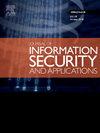一种改进的基于模糊提取的无线体域网络生物特征认证与密钥协议方案
IF 3.7
2区 计算机科学
Q2 COMPUTER SCIENCE, INFORMATION SYSTEMS
Journal of Information Security and Applications
Pub Date : 2025-04-20
DOI:10.1016/j.jisa.2025.104047
引用次数: 0
摘要
无线身体区域网络(wban)支持人体周围设备之间的数据通信,广泛应用于医疗保健和健康监测等领域。由于无线宽带网络中传输数据的敏感性、设备资源的有限性以及突发事件下通信效率的要求,如何构建一种高效、安全的认证与密钥协商方案来满足无线宽带网络的需求仍然是一个巨大的挑战。最近,为了在wban中安全交换敏感数据,Zhang等人(2024)设计了一种使用模糊提取器的生物特征认证和密钥协议协议。但深入分析表明,该方案不能有效抵御中间人攻击,稳定性不足。为了解决这些问题,我们提出了一种改进的生物识别认证和密钥协议方案。该方案主要采用模糊提取技术、生物识别技术和椭圆曲线密码技术。用户不需要存储任何信息,只需要发送一次消息即可完成认证,保护了用户的隐私,更适合资源有限的wban设备。通过正式和非正式的安全性分析证明了该方案的安全性。此外,我们还对该方案的计算复杂度和安全性进行了综合评价。评估表明,与Zhang等人(2024)的方案相比,我们的方案提供了更好的安全性,并且减少了计算和通信开销。本文章由计算机程序翻译,如有差异,请以英文原文为准。
An improved biometric authentication and key agreement scheme based on fuzzy extractor for Wireless Body Area Networks
Wireless Body Area Networks (WBANs) support data communication between devices around the human body and are widely used in areas such as healthcare and health monitoring. Due to the sensitivity of transmitted data in WBANs, the restriction of device resources, and the requirement of communication efficiency in emergencies, it remains a great challenge to construct an efficient and secure authentication and key agreement scheme to meet the needs of WBANs. Recently, for the secure exchange of sensitive data in WBANs, Zhang et al. (2024) designed a biometric authentication and key agreement protocol using fuzzy extractor. However, an in-depth analysis reveals that the scheme cannot effectively withstand man-in-the-middle attacks and is insufficient in stability. To address the issues, we propose an improved biometric authentication and key agreement scheme. The solution mainly uses fuzzy extraction techniques, biometrics and elliptic curve cryptography. The user is not required to store any information and only requires to send the message once to complete the authentication, which protects the user’s privacy and is more appropriate for WBANs devices with limited resources. The security of our scheme is demonstrated by formal and informal security analysis. Additionally, we comprehensively evaluate the calculation complexity and security characteristics of this scheme. The evaluation shows our scheme provides both better security as well as reduced computational and communication overheads compared with Zhang et al. (2024)’s scheme.
求助全文
通过发布文献求助,成功后即可免费获取论文全文。
去求助
来源期刊

Journal of Information Security and Applications
Computer Science-Computer Networks and Communications
CiteScore
10.90
自引率
5.40%
发文量
206
审稿时长
56 days
期刊介绍:
Journal of Information Security and Applications (JISA) focuses on the original research and practice-driven applications with relevance to information security and applications. JISA provides a common linkage between a vibrant scientific and research community and industry professionals by offering a clear view on modern problems and challenges in information security, as well as identifying promising scientific and "best-practice" solutions. JISA issues offer a balance between original research work and innovative industrial approaches by internationally renowned information security experts and researchers.
 求助内容:
求助内容: 应助结果提醒方式:
应助结果提醒方式:


